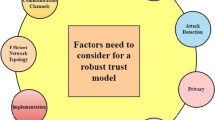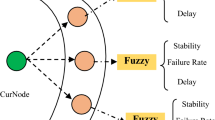Abstract
Vehicular Ad Hoc Network (VANET) is a key component in the Intelligent Transportation System (ITS) with a number of applications for safety, traffic management, emergency services, entertainment, and so on. These applications are implemented by exchanging data among the nodes in an open, dynamic, and distributed fashion, and hence VANETs are vulnerable to different network attacks. For examples, DoS and black-hole attacks can be easily executed in VANETs, and strongly affect the routing protocol and its functionality. Through the nature of VANETs, trust management is considered one of the practical means to secure these networks. In this paper, we propose an up-to-date dynamic entity-centric trust model for VANETs, called T-AODV. We use social science techniques to apply weight and fuzzy logic theory and identify the malicious nodes. Our NS2 simulation results indicate that T-AODV can be more resists in contact with black-hole attacks by boosting the security of AODV routing protocol. T-AODV slightly increases the routing overhead of AODV and provides better performance than the existing I-AODV scheme.











Similar content being viewed by others
Data availability
All data generated or analyzed during this study are included in this published article.
References
Han S-Y, Zhang C-Y (2022) ASMAC: An adaptive slot access MAC protocol in distributed VANET. Electronics 11(7):1145
Li W, Song H (2015) ART: An attack-resistant trust management scheme for securing vehicular Ad Hoc networks. IEEE Trans Intell Transp Syst 17(4):960–969
Al-Qassas RS (2016) Routing and the impact of group mobility model in VANETs. J Comput Sci 12(4):223–231
Arshad M, Ullah Z, Ahmad N, Khalid M, Criuckshank H, Cao Y (2018) A survey of local/cooperative-based malicious information detection techniques in VANETs. EURASIP J Wirel Commun Netw 2018(1):1–17
Tripathi KN, Sharma SC (2020) A trust based model (TBM) to detect rogue nodes in vehicular ad-hoc networks (VANETS). Int J Syst Assur Eng Manag 11(2):426–440
Aslan M, Sen S (2019) Evolving trust formula to evaluate data trustworthiness in VANETs using genetic programming. Int Conf Appl Evol Comput (Part of EvoStar). Springer, pp 413–429
Kumar A, Varadarajan V, Kumar A, Dadheech P, Choudhary SS, Kumar VA, Panigrahi BK, Veluvolu KC (2021) Black-hole attack detection in vehicular ad-hoc network using secure AODV routing algorithm. Microprocess Microsyst 80:103352
Soleymani SA, Abdullah AH, Hassan WH, Anisi MH, Goudarzi S, Rezazadeh Baee MA, Mandala S (2015) Trust management in vehicular Ad Hoc network: a systematic review. EURASIP J Wirel Commun Netw 2015(1):1–22
Souissi I, Azzouna NB, Berradia T (2017) Towards a self-adaptive trust management model for VANETs. SECRYPT 513–518
Tripathi KN, Yadav AM, Sharma S (2022) Fuzzy and deep belief network based malicious vehicle identification and trust recommendation framework in VANETs. Wirel Pers Commun 1–30
Yao X, Zhang X, Ning H, Li P (2017) Using trust model to ensure reliable data acquisition in VANETs. Ad Hoc Netw 55:107–118
Paranjothi A, Khan MS, Zeadally S, Pawar A, Hicks D (2019) GSTR: Secure multi-hop message dissemination in connected vehicles using social trust model. Internet Things 7:100071
Ahmed W, Wu D, Mukathie D (2022) Blockchain-assisted trust management scheme for securing VANETs. KSII Trans Internet Inf Syst (TIIS) 16(2):609–631
Kerrache CA, Lagraa N, Calafate CT, Cano J-C, Manzoni P (2016) T-VNets: A novel trust architecture for vehicular networks using the standardized messaging services of ETSI ITS. Comput Commun 93:68–83
Lu Z, Wang Q, Qu G, Liu Z (2018) BARS: A blockchain-based anonymous reputation system for trust management in VANETs. In 2018 17th IEEE International Conference on Trust, Security and Privacy in Computing And Communications/12th IEEE International Conference on Big Data Science and Engineering (TrustCom/BigDataSE), IEEE, pp. 98–103
Chowdhury A, Karmakar G, Kamruzzaman J (2019) Trusted autonomous vehicle: Measuring trust using on-board unit data. In 2019 18th IEEE International conference on trust, security and privacy in computing and communications/13th IEEE international conference on big data science and engineering (TrustCom/BigDataSE), IEEE, pp. 787–792
Tajeddine A, Kayssi A, Chehab A, Artail H (2011) Fuzzy reputation-based trust model. Appl Soft Comput 11(1):345–355
Simaremare H, Abouaissa A, Sari RF, Lorenz P (2013) Secure AODV routing protocol based on trust mechanism. Wirel Netw Secur: Springer, pp. 81–105
Mármol FG, Pérez GM (2012) TRIP, a trust and reputation infrastructure-based proposal for vehicular Ad Hoc networks. J Netw Comput Appl 35(3):934–941
Souissi I, Azzouna NB, Berradia T, Said LB (2018) Fuzzy logic based model for energy consumption trust estimation in electric vehicular networks. ICETsE (2):387–399
Soleymani SA, Abdullah AH, Zareei M, Anisi MH, Vargas-Rosales C, Khan MK, Goudarzi S (2017) A secure trust model based on fuzzy logic in vehicular Ad Hoc networks with fog computing. IEEE Access 5:15619–15629
Mahmood A, Butler B, Zhang WE, Sheng QZ, Siddiqui SA (2019) A hybrid trust management heuristic for VANETs. In 2019 IEEE International Conference on Pervasive Computing and Communications Workshops (PerCom Workshops), IEEE, pp. 748–752
Gazdar T, Belghith A, Abutair H (2017) An enhanced distributed trust computing protocol for VANETs. IEEE Access 6:380–392
**a H, Zhang SS, Li BX, Li L, Cheng XG (2018) Towards a novel trust-based multicast routing for VANETs. Secur Commun Netw 2018
Sindhwani M, Singh R, Sachdeva A, Singh C (2022) Improvisation of optimization technique and AODV routing protocol in VANET. Mater Today: Proc 49:3457–3461
** S, Li X-M (2008) Study of the feasibility of VANET and its routing protocols. Int Conf Wirel Commun Netw Mob Comput, IEEE, pp. 1–4
Toor Y, Muhlethaler P, Laouiti A, De La Fortelle A (2008) Vehicle Ad Hoc networks: Applications and related technical issues. IEEE Commun Surv Tutor 10(3):74–88
Akhlaq M, Jafri MN, Khan MA, Aslam B (2008) Addressing security concerns of data exchange in AODV protocol. Int J Inf Commun Eng 2(4):677–681
Jun L, Zhe L, Dan L, Ye L (2005) A security enhanced AODV routing protocol based on the credence mechanism. Proc Int Conf Wirel Commun Netw Mob Comput 2:719–722. IEEE
Sakiz F, Sen S (2017) A survey of attacks and detection mechanisms on intelligent transportation systems: VANETs and IoV. Ad Hoc Netw 61:33–50
Castelfranchi C, Falcone R, Pezzulo G (2003) Trust in information sources as a source for trust: a fuzzy approach. Proc Int Joint Conf Auton Agents Multiagent Syst 89–96
Jyothi N, Patil R (2022) A fuzzy-based trust evaluation framework for efficient privacy preservation and secure authentication in VANET. J Inf Telecommun 1–19
Yu H, Shen Z, Miao C, Leung C, Niyato D (2010) A survey of trust and reputation management systems in wireless communications. Proc IEEE 98(10):1755–1772
Yang H (2020) A study on improving secure routing performance using trust model in MANET. Mob Inf Syst 2020
Hussain R, Lee J, Zeadally S (2021) Trust in VANET: A survey of current solutions and future research opportunities. IEEE Trans Intell Transp Syst 22(5):2553–2571
Liao L, Zhao J, Hu H, Sun X (2022) Secure and efficient message authentication scheme for 6G-Enabled VANETs. Electronics 11(15):2385
Shankar TN, Padhy S, Ch SM, Ravella H, Varun M, Kumar N (2022) Development of 6G web by Multilayer Perceptron in C-RAN for VANETs. IEEE Glob Conf Comput Power Commun Technol (GlobConPT) 1–6
Funding
No funds, grants, or other support was received.
Author information
Authors and Affiliations
Contributions
1- Farnam Honarmand wrote the main manuscript and prepared all figures and tables based on his simulation results. 2- Alireza Keshavarz-Haddad was the adviser of this research. He edited the paper and he is responsible for the content as the corresponding author.
Corresponding author
Ethics declarations
Ethics approval
Not applicable.
Consent to publish
All authors unanimously agree to publish the paper.
Competing interests
The authors declare no competing interests.
Additional information
Publisher's Note
Springer Nature remains neutral with regard to jurisdictional claims in published maps and institutional affiliations.
This article is part of the Topical Collection: 1- Track on Networking and Applications
Guest Editor: Vojislav B. Misic
Rights and permissions
Springer Nature or its licensor (e.g. a society or other partner) holds exclusive rights to this article under a publishing agreement with the author(s) or other rightsholder(s); author self-archiving of the accepted manuscript version of this article is solely governed by the terms of such publishing agreement and applicable law.
About this article
Cite this article
Honarmand, F., Keshavarz-Haddad, A. T-AODV: A trust-based routing against black-hole attacks in VANETs. Peer-to-Peer Netw. Appl. 17, 1309–1321 (2024). https://doi.org/10.1007/s12083-024-01632-y
Received:
Accepted:
Published:
Issue Date:
DOI: https://doi.org/10.1007/s12083-024-01632-y




